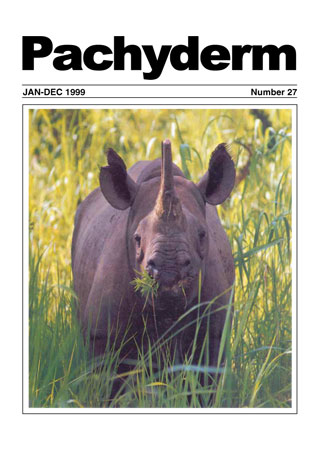Human activities on Mount Kenya from an elephant's perspective
DOI:
https://doi.org/10.69649/pachyderm.v27i1.976Abstract
Outlines the ongoing study on 'Daily activities, habitat use and movement of elephants on Mount Kenya' recording human and elephant presence in the mountain forests. The Mount Kenya area and Imenti FR to the northeast have been divided into four area blocks wherein a series of line transects totally 263 km positioned to dissect all altitude clines and forest types. Evidence of poaching, logging, elephant paths, dung, and direct observation of mammals are recorded. Position and distance are calculated using the Global Positioning System (GPS) and topofil. Aerial photography was taken at 500m and 1km intervals depending on the extent and occurrence of disturbances in a survey of Mount Kenya, and Imenti and Ndare Ngare FRs that divided the area into 9 blocks. Results of each damage or threat were incorporated into a GPS using ArcView. Elephants tend to avoid steep slopes and areas with intense human presence. When calculated as a percentage of the total number of observations per forest type and proportional to the transect length walked in each forest type the presence of elephant was highest in bamboo/Podocarpus forests (28.9%) in forest clearing/open spaces (26.9%) and in bushland (20.1%)
Downloads
Published
How to Cite
Issue
Section
License
Copyright (c) 1999 Hilde Vanleeuwe, Christian Lambrechts

This work is licensed under a Creative Commons Attribution-NonCommercial 4.0 International License.




